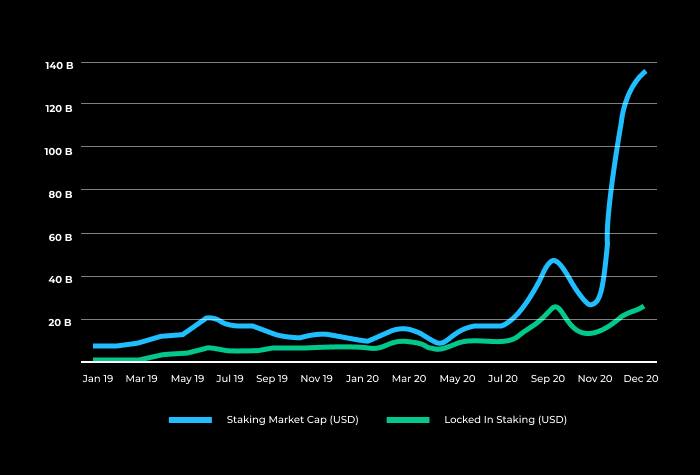In 2020, the cryptocurrency industry increased by over 330% in market cap from 179 billion USD to 770 billion USD. Furthermore, the total value locked in Proof of Stake (PoS) grew by over 4000% from 628 million USD to over 28.8 billion USD.
While staking has helped crypto-enthusiasts earn higher rewards than ever before, they are yet to explore its full potential.
Let’s first understand more about the staking world.
The Rise of Staking
PoS mechanism is one of the most innovative solutions to achieve a distributed consensus.
PoS comes with several improvements to the Proof of Work (PoW) system, such as better energy efficiency, higher transaction throughput, and more hardware flexibility.
We’ve seen an implication of this in 2020, where the staking market cap jumped from 9.9 billion USD to 134.6 billion USD. The launch of Ethereum 2.0 is another milestone in the staking world. With a market cap of 84 billion USD, as of December 2020, the staking market cap will continue to rise.

These technological advancements have opened up a plethora of new possibilities for crypto-enthusiasts to grow their profits significantly. However, staking has its own set of problems that can restrict users from earning the maximum possible rewards.
The Challenges in Staking Your Assets
Staking restricts your freedom and prevents you from making the most of your crypto.
Some of the challenges include:
- Networks hold staked assets in an escrow contract to register the delegator in the consensus and secure the network. While they receive continuous staking rewards, fundamentally, the staked assets are inaccessible to the token holder.
- Staking usually requires an unbonding period, the time the token holder will have to wait before the assets can be sold or transferred. This period can range from one-two days to even four months, depending on the network.
- Opportunity costs top all the other issues with staking. With the rise of DeFi, staked assets have no way to participate.
Liquid Staking — An Innovative Solution
Various cryptocurrency giants have attempted to resolve staking issues by enabling liquid staking.
Through tokenization, liquid staking protocols allow token holders to get liquidity on staked assets and enable their usage in decentralized finance (DeFi) applications to earn additional rewards.
There are primarily five categories of liquid staking solutions:
- Native — These are protocols that issue the derivative for staked assets at the core protocol level and make it ineffective for other platforms to create liquidity representations. Example: Acala Network
- Collateralized Loan — In this approach, a separate trustless protocol issues liquidity for staked assets and allows users to mint stable coins making their assets liquid. Example: Ramp Defi
- ETH 2.0 — These are protocols specifically catering to Ethereum (ETH) and issue the derivative for staked assets at the core protocol level. Example: Rocket Pool
- Custodial — In this approach, a centralized entity controls the private keys and issues representations of staking rewards. These platforms may also require users to do a KYC. Example: Stakehound
- Exchange — In this approach, centralized exchanges allow token holders to participate in other products on their platform. Example: Binance, Kraken
While each approach has its potential strengths and weaknesses, they don’t qualify all the characteristics of an ideal liquid staking solution.
They are either centralized hence lack transparency or fail to allow cross-chain communication. Thus, limiting users to participate in the Ethereum DeFi ecosystem.
Above all, these approaches lack user experience fundamentals, making it extremely difficult to use the applications, thus not allowing users to maximize their rewards by participating in both staking and DeFi and ecosystems.
ClayStack — Staking ReDeFined
ClayStack opts for a novel approach towards staking. We use oracles and relayers to have interchain communication possible with any blockchain.
Users deposit tokens to ClayStack smart contracts and mint the equivalent derivative token directly on Ethereum.
The tokens are staked to the professional validators, and the rewards are sent daily to all the derivate token holders. Users can further use the derivative/synthetic tokens in DeFi applications and maximize their earning potential.
Exclusive features of ClayStack
- 1:1 staking derivatives that are fungible, transferable, and tradable.
- Liquidity providers earn incentives through CLAY tokens to make derivatives markets liquid.
- Multi-blockchains support, enabling you to engage with different blockchains at no extra cost.
- Everything is transparent and executed on-chain.
- No lock-up periods. This means you can sell or transfer your staked tokens whenever you want.
- No minimums — you can choose to stake as many tokens as you want.
- No compromise with the network’s liquidity, especially during market volatility peaks when investors invest their tokens in other applications.
Upcoming Developments in ClayStack
Last few months, we have been working relentlessly on building the product and enhancing the overall user experience. We have also raised pre-seed funding from top CXOs in the blockchain ecosystem.
The next few months are going to be crazier! We are already working with multiple networks to provide a liquidity solution and will soon announce the partnerships.
Join our community!
Be part of our adventurous and thrilling journey. We will be launching the alpha test program in the coming weeks. To be the first to use our product and contribute to its growth, register for the alpha launch.
Follow us on Twitter and Telegram to stay updated with our news and upcoming announcements.
The merging of DeFi and Staking will be a paradigm shift in the cryptocurrency world, and we will be in the driver’s seat.